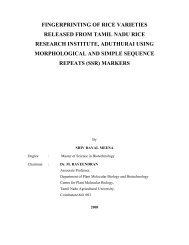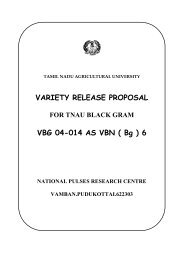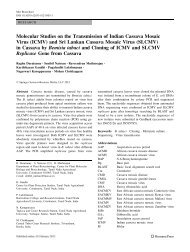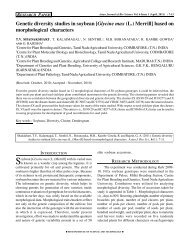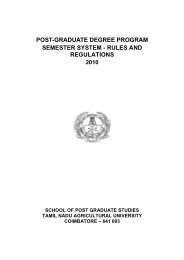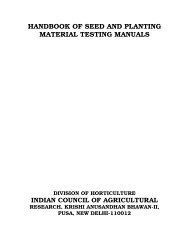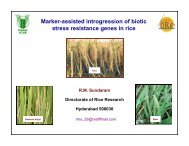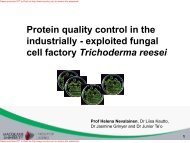MBB 601 Advances in Plant Molecular Biology 3+ ... - TNAU Genomics
MBB 601 Advances in Plant Molecular Biology 3+ ... - TNAU Genomics
MBB 601 Advances in Plant Molecular Biology 3+ ... - TNAU Genomics
Create successful ePaper yourself
Turn your PDF publications into a flip-book with our unique Google optimized e-Paper software.
BiotechnologyCourse Code Course Title Credit hoursMajor (15 Credits)<strong>MBB</strong> <strong>601</strong> <strong>Advances</strong> <strong>in</strong> <strong>Plant</strong> <strong>Molecular</strong> <strong>Biology</strong> <strong>3+</strong>0<strong>MBB</strong> 602 <strong>Advances</strong> <strong>in</strong> Genetic Eng<strong>in</strong>eer<strong>in</strong>g <strong>3+</strong>0<strong>MBB</strong> 603 <strong>Advances</strong> <strong>in</strong> Microbial Biotechnology <strong>3+</strong>0<strong>MBB</strong> 604* <strong>Advances</strong> <strong>in</strong> Crop Biotechnology 2+0<strong>MBB</strong> 605 <strong>Advances</strong> <strong>in</strong> Functional <strong>Genomics</strong> and Proteomics 2+0<strong>MBB</strong> 606 Commercial <strong>Plant</strong> Tissue Culture 2+0M<strong>in</strong>or (8 Credits)PBG 604 Cellular and chromosomal manipulations <strong>in</strong> crop improvement 2+1CRP 605 Climate change and crop growth 2+0PAT 604 <strong>Molecular</strong> basis of Host-Pathogen Interaction 2+1Support<strong>in</strong>g Courses (5 Credits)<strong>MBB</strong> 504 <strong>Plant</strong> Tissue Culture and Genetic Transformation 1+2<strong>MBB</strong> 555 Introduction to Bio<strong>in</strong>formatics (BIF 501) 2+1PPG <strong>601</strong> <strong>Plant</strong> Genetic Resources and their Utilization 2+0AGM 503 Microbial Genetics 2+1PAT 503 Physiological and <strong>Molecular</strong> response of plants to abiotic stresses 2+1ENT 608 Advanced host plant resistance 1+1MAT 604* Mathematical Model<strong>in</strong>g for agricultural sciences 1+1Sem<strong>in</strong>ar and Research<strong>MBB</strong> 691 Sem<strong>in</strong>ar I 0+1<strong>MBB</strong> 692 Sem<strong>in</strong>ar II 0+1<strong>MBB</strong> 699 Research 0+45* Compulsory courses
<strong>MBB</strong> <strong>601</strong> ADVANCES IN PLANT MOLECULAR BIOLOGY <strong>3+</strong>0ObjectiveTo discuss the specialized topics and recent advances <strong>in</strong> the field of plant molecular biology.TheoryUNIT IArabidopsis <strong>in</strong> molecular biology, Forward and Reverse Genetic Approaches, Transcriptional andpost-transcriptional regulation of gene expression, isolation of promoters and other regulatoryelements.UNIT IIRNA <strong>in</strong>terference, Transcriptional gene silenc<strong>in</strong>g, Transcript and prote<strong>in</strong> analysis, use of transcriptprofil<strong>in</strong>g to study biological systems.UNIT IIIHormone regulatory pathways: Ethylene, Cytok<strong>in</strong><strong>in</strong>, Aux<strong>in</strong> and ABA, SA and JA; ABC Model ofFloral Development, <strong>Molecular</strong> basis of self <strong>in</strong>compatibility. Signal transduction and receptors.UNIT IV<strong>Molecular</strong> biology of abiotic stress responses: Cold, high temperature, submergence, dehydration,sal<strong>in</strong>ity and drought; <strong>Molecular</strong> <strong>Biology</strong> of plant-pathogen <strong>in</strong>teractions, molecular biology ofAgrobacterium <strong>in</strong>fection, <strong>Molecular</strong> biology of Rhizobium <strong>in</strong>fection (molecular mechanisms <strong>in</strong>symbiosis), Programmed cell death <strong>in</strong> development and defense.Lecture schedule1. Arabidopsis as a model plant <strong>in</strong> molecular biology2. The genetic basis of a phenotype or trait3. Expression of a phenotype by a particular gene4. Reverse Genetic Approaches <strong>in</strong> functional genomics5. Reverse Genetic Approaches <strong>in</strong> functional genomics (cont…)6. Transcriptional and post-transcriptional regulation of gene expression7. Transcriptional and post-transcriptional regulation of gene expression (cont…)8. Promoters and their role <strong>in</strong> gene expression9. Isolation of promoters and other regulatory elements10. RNA <strong>in</strong>terference – micro RNAs and small <strong>in</strong>terfer<strong>in</strong>g RNAs11. Mode of action <strong>in</strong> RNAi system12. RNA dependent gene silenc<strong>in</strong>g13. Transcriptional gene silenc<strong>in</strong>g14. Post transcriptional gene silenc<strong>in</strong>g15. RNA viruses <strong>in</strong> post transcriptional gene silenc<strong>in</strong>g16. Suppression of gene silenc<strong>in</strong>g by plant viruses17. Application of RNAi technology <strong>in</strong> plant biotechnology18. Transcript analysis to study biological systems.19. Prote<strong>in</strong> analysis to study biological systems.20. Regulation of cellular processes by different hormones21. Role of hormones <strong>in</strong> flower<strong>in</strong>g22. Role of hormones <strong>in</strong> fruit ripen<strong>in</strong>g1
23. Role of hormones <strong>in</strong> seed germ<strong>in</strong>ation24. Role of hormones <strong>in</strong> senescence25. Mid semester exam26. JA <strong>in</strong> signal transduction27. ABC Model of Floral Development28. <strong>Molecular</strong> basis of self <strong>in</strong>compatibility29. Signal transduction – over view30. Plasma membrane receptors31. Prote<strong>in</strong> k<strong>in</strong>ases32. G prote<strong>in</strong>s <strong>in</strong> signal transduction33. Pr<strong>in</strong>ciples of stress perception34. Signal transduction pathway35. Regulation of gene expression36. <strong>Molecular</strong> biology of sal<strong>in</strong>ity stress tolerance <strong>in</strong> plants37. <strong>Molecular</strong> biology of drought tolerance <strong>in</strong> plants38. The heat shock response <strong>in</strong> higher plants.39. <strong>Molecular</strong> biology of low temperature response <strong>in</strong> plants40. <strong>Molecular</strong> biology and genomics of flood<strong>in</strong>g41. Response and adaptation by plants to flood<strong>in</strong>g stress.42. <strong>Molecular</strong> responses to dehydration <strong>in</strong> plants.43. <strong>Molecular</strong> mechanisms <strong>in</strong>volved <strong>in</strong> Agrobacterium <strong>in</strong>fection of plant cells44. <strong>Molecular</strong> mechanisms <strong>in</strong>volved <strong>in</strong> Agrobacterium <strong>in</strong>fection of plant cells (cotnd…)45. Use of Agrobacterium as a biotechnological tool for genetic46. <strong>Molecular</strong> biology of Rhizobium <strong>in</strong>fection47. Nodulation genes48. Nod factor signal<strong>in</strong>g and <strong>in</strong>fection <strong>in</strong> Rhizobium-legume symbiosis49. Programmed cell death(PCD) or Apoptosis <strong>in</strong> plants50. Occurrence and necessity of PCD for plant development and defense51. Occurrence and necessity of PCD for plant defenseSuggested Text books1. Buchanan B, Gruissen W & Jones R. 2000. Biochemistry and <strong>Molecular</strong> <strong>Biology</strong> of <strong>Plant</strong>s.American Society of <strong>Plant</strong> Physiologists, USA.2. Lew<strong>in</strong> B. 2008. Gene IX. Peterson Publications/Panima.3. Malac<strong>in</strong>ski GM & Freifelder D. 1998. Essentials of <strong>Molecular</strong> <strong>Biology</strong>. 3 rd Ed. Jones &Bartlett Publ.4. Nelson DL & Cox MM. 2007. Lehn<strong>in</strong>ger’s Pr<strong>in</strong>ciples of Biochemistry. WHFreeman & Co.5. Watson JD, Bakee TA, Bell SP, Gann A, Lev<strong>in</strong>e M & Losick R. 2008. <strong>Molecular</strong> <strong>Biology</strong> ofthe Gene. 6th Ed. Pearson Education.Suggested Web siteshttp://www.elsevier.com/wps/f<strong>in</strong>d/journaldescription.cws_home/journal of molecular biologyhttp://www.cellbio.com/elecpubs.html (molecular biology today - journal)www.spr<strong>in</strong>ger.com/life+sciences/plant+sciences/journal/11103(plant molecular biology)http://www.ebooksx.com/Arabidopsis-Protocols-2nd-Edition-Methods-<strong>in</strong>-<strong>Molecular</strong>-<strong>Biology</strong>-_208282.html2
<strong>MBB</strong> 602 ADVANCES IN GENETIC ENGINEERING <strong>3+</strong>0ObjectiveTo discuss the specialized topics and advances <strong>in</strong> field of genetic eng<strong>in</strong>eer<strong>in</strong>g and their application<strong>in</strong> crop improvement.TheoryUNIT IGeneral overview of transgenic plants; Case studies: Genetic eng<strong>in</strong>eer<strong>in</strong>g of herbicide resistance,Transgenic plants resistant to <strong>in</strong>sects/pests, Genetic eng<strong>in</strong>eer<strong>in</strong>g of abiotic stress tolerance,Eng<strong>in</strong>eer<strong>in</strong>g food crops for quality – nutritional quality and shelf life, Genetically eng<strong>in</strong>eeredpoll<strong>in</strong>ation control, Induction of male sterility <strong>in</strong> plants.UNIT II<strong>Molecular</strong> farm<strong>in</strong>g of plants for applications <strong>in</strong> veter<strong>in</strong>ary and human medic<strong>in</strong>e systems: Boost<strong>in</strong>gheterologous prote<strong>in</strong> production <strong>in</strong> transgenics, Rapid production of specific vacc<strong>in</strong>es, High-yieldproduction of therapeutic prote<strong>in</strong>s <strong>in</strong> chloroplasts.UNIT IIIRecent developments <strong>in</strong> plant transformation strategies; Role of antisense and RNAi-based genesilenc<strong>in</strong>g <strong>in</strong> crop improvement – silenc<strong>in</strong>g endogenous gene, virus resistance and <strong>in</strong>sect resistance;Regulated and tissue-specific expression of transgenes for crop improvement; Gene stack<strong>in</strong>g;Pathway eng<strong>in</strong>eer<strong>in</strong>g; Marker-free transgenic development strategies; High throughput phenotyp<strong>in</strong>gof transgenic plants.UNIT IVField studies with transgenic crops; Bio-safety studies - Environmental issues associated withtransgenic crops; Food and feed safety issues associated with transgenic crops; Risk assessmentof transgenic food crops. Current status of transgenic plantsLecture Schedule:1. General overview of transgenic plants2. Genetic eng<strong>in</strong>eer<strong>in</strong>g of herbicide resistance3. Transgenic plants resistant to <strong>in</strong>sects/pests4. Novel Bt prote<strong>in</strong>s and plant derived <strong>in</strong>secticidal genes5. Genetic eng<strong>in</strong>eer<strong>in</strong>g for resistance to diseases – fungal disease6. Genetic eng<strong>in</strong>eer<strong>in</strong>g for resistance to diseases – bacterial disease7. Genetic eng<strong>in</strong>eer<strong>in</strong>g for resistance to diseases – viral disease8. Genetic eng<strong>in</strong>eer<strong>in</strong>g of drought tolerance9. Eng<strong>in</strong>eer<strong>in</strong>g for salt stress10. Eng<strong>in</strong>eer<strong>in</strong>g for flood<strong>in</strong>g tolerance, heat stress11. Eng<strong>in</strong>eer<strong>in</strong>g food crops for quality – prote<strong>in</strong>12. Eng<strong>in</strong>eer<strong>in</strong>g food crops for enhanced vitam<strong>in</strong> and m<strong>in</strong>eral content13. Genetic eng<strong>in</strong>eer<strong>in</strong>g to manipulate fatty acid composition of oilseed crops14. Genetic eng<strong>in</strong>eer<strong>in</strong>g for shelf life of fruits and vegetables15. Genetically eng<strong>in</strong>eered poll<strong>in</strong>ation control16. Induction of geneic male sterility <strong>in</strong> plants and production of F1 hybrids17. <strong>Molecular</strong> pharm<strong>in</strong>g –<strong>in</strong>troduction18. <strong>Plant</strong>s as bioreactor for production of recomb<strong>in</strong>ant prote<strong>in</strong>s3
19. Over-expression of heterologous prote<strong>in</strong>s <strong>in</strong> plants20. Downstream process<strong>in</strong>g of heterologous prote<strong>in</strong>s produced <strong>in</strong> plants21. Production of edible vacc<strong>in</strong>es22. Production of recomb<strong>in</strong>ant antibodies <strong>in</strong> plants23. Target plants for synthesis of pharmaceutical prote<strong>in</strong>s24. Over expression of recomb<strong>in</strong>ant prote<strong>in</strong>s <strong>in</strong> chloroplast25. Expression of <strong>in</strong>dustrial products <strong>in</strong> plants26. Mid semester exam27. Over view of latest development <strong>in</strong> transgenic technology28. Agrobacterium and particle bombardment mediated methods29. Recent advances <strong>in</strong> transformation technologies30. Chloroplast transformation31. Strategies for over-expression – design of transgene32. RNAi technology for gene suppression33. Applications of RNAi technology – <strong>in</strong>sect and disease resistance34. Applications of RNAi technology – manipulation of biochemical pathways35. Regulation of transgene expression – tissue and temporal specific expression36. Transformation of multiple genes or gene stack<strong>in</strong>g – case studies37. Metabolic pathway eng<strong>in</strong>eer<strong>in</strong>g – case studies38. Metabolic pathway eng<strong>in</strong>eer<strong>in</strong>g – case studies39. Concerns of marker genes, new marker genes40. Generation of marker free transgenic plants41. Analysis of transgenic plants – molecular and biochemical analyses42. High throughput phenotyp<strong>in</strong>g of transgenic plants43. Field evaluation of transgenic crops – guidel<strong>in</strong>es44. Concerns of transgenic plants45. Bio-safety studies - Environmental safety assessment of transgenic crops46. Food and feed safety issues associated with transgenic crops47. Risk assessment of transgenic food crops48. Bio-safety Regulatory frame work <strong>in</strong> US and Europe49. Bio-safety Regulatory system <strong>in</strong> India50. Commercialized transgenic plants51. Global and Indian statusSuggested Read<strong>in</strong>gs1. Christou P & Klee H. 2004. Handbook of <strong>Plant</strong> Biotechnology. John Wiley & Sons.2. Slater, A., Nigel, S and M. Fowler. 2003. <strong>Plant</strong> Biotechnology: The Genetic Manipulation of<strong>Plant</strong>s. Oxford Publications3. Kirsi-Marja, Oksman-Caldentey, and WH. Barz (Eds.). <strong>Plant</strong> Biotechnology and Transgenicplants. CHIPS, Texas4. O. Koul and G.S. Dhaliwal (2004) Transgenic crop protection: Concepts and strategies.Oxford & IBH, New DelhiSuggested Websites1. http://www.spr<strong>in</strong>ger.com/biomed/molecular/journal/11248 (Transgenic Research)2. http://www.spr<strong>in</strong>gerl<strong>in</strong>k.com/content/100317/ (<strong>Molecular</strong> Breed<strong>in</strong>g)3. http://www.wiley.com/bw/journal.asp?ref=1467-7644 (<strong>Plant</strong> Biotechnology Journal)4
<strong>MBB</strong> 603 ADVANCES IN MICROBIAL BIOTECHNOLOGY <strong>3+</strong>0ObjectiveTo discuss specialized topics about <strong>in</strong>dustrially important microorganisms.TheoryUNIT IFermentative metabolism and development of bio-process<strong>in</strong>g technology, process<strong>in</strong>g andproduction of recomb<strong>in</strong>ant products; isolation, preservation and improvement of <strong>in</strong>dustriallyimportant microorganisms.UNIT IIImmobilization of enzymes and cells; Batch, plug flow and chemo-state-cultures; Computersimulations; Fed-batch and mixed cultures; Scale-up pr<strong>in</strong>ciples; Down stream process<strong>in</strong>g etc.UNIT IIICurrent advances <strong>in</strong> production of antibiotics, vacc<strong>in</strong>es, and biocides; Steroid transformation;Bioreactors; Bioprocess eng<strong>in</strong>eer<strong>in</strong>g; Production of non-microbial orig<strong>in</strong> products by geneticallyeng<strong>in</strong>eered microorganisms.UNIT IVConcept of probiotics and applications of new tools of biotechnology for quality feed/foodproduction; Microorganisms and prote<strong>in</strong>s used <strong>in</strong> probiotics; Lactic acid bacteria as live vacc<strong>in</strong>es;Factors affect<strong>in</strong>g delignification; Bioconversion of substrates, anti-nutritional factors present <strong>in</strong>feeds; Microbial detoxification of aflatox<strong>in</strong>s; S<strong>in</strong>gle cell prote<strong>in</strong>, Bio-<strong>in</strong>secticides; Bio-fertilizers;Recent advances <strong>in</strong> microbial biotechnology.Lecture Schedule1. Microbial biotechnology: Scope and techniques.2. Fermentative diversity -Utilization of hexoses by fermentative pathways3. Fermentative diversity-Utilization of pentoses, polysaccharides and organic acid metabolisms4. Fermentation- Microbial Growth K<strong>in</strong>etics- applications of Fermentation5. Development of bioprocess technology and production of recomb<strong>in</strong>ant products6. Recomb<strong>in</strong>ant DNA products for human therapeutic use7. Recomb<strong>in</strong>ant DNA products – Challenges and future thrust8. Isolation, screen<strong>in</strong>g of <strong>in</strong>dustrially important microorganisms9. Selection and Preservation of <strong>in</strong>dustrially important microorganisms10. Stra<strong>in</strong> improvement of <strong>in</strong>dustrially important microorganisms-11. Stra<strong>in</strong> improvement- the random and empirical approach12. Case studies- stra<strong>in</strong> improvement - Recomb<strong>in</strong>ant DNA approaches for low and medium valueproducts13. Case studies- stra<strong>in</strong> improvement-Recomb<strong>in</strong>ant DNA approaches- for high value recomb<strong>in</strong>antproducts14. Pr<strong>in</strong>ciples of immobilization- techniques and importance15. Immobilization of enzymes and cells - Current trends and future Prospects16. Case studies- Immobilized cell technology – Flavour maturation of green beer17. Case studies- Immobilized cell technology alcohol free beer18. Case studies- Application of Immobilized Enzymes <strong>in</strong> pharmaceutical <strong>in</strong>dustry19. Bioreactors - types, designs and functional characteristics, computer simulations and Bioprocess5
eng<strong>in</strong>eer<strong>in</strong>g20. Dual and mixed <strong>in</strong>oculations - cont<strong>in</strong>uous and batch fermentations; plug flow and chemostatcultures21. Fed-batch cultures- Scale up Pr<strong>in</strong>ciples and applications22. Downstream Process<strong>in</strong>g – on overview23. Downstream Process<strong>in</strong>g – Pr<strong>in</strong>ciples and application of RIPP technology24. Case studies on Down stream process<strong>in</strong>g of High value and Low volume Products25. Case studies on Down stream process<strong>in</strong>g of Medium value and Medium volume Products26. Case studies on Down stream process<strong>in</strong>g of Low value and High volume Products27. Mid semester exam28. Production of Secondary metabolites- antibiotics – Problems and Future thrust29. Recomb<strong>in</strong>ant and Synthetic Vacc<strong>in</strong>es Problems with Traditional Vacc<strong>in</strong>es30. Impact of Biotechnology on Vacc<strong>in</strong>e Development; Mechanisms for Produc<strong>in</strong>g Immunity31. Improv<strong>in</strong>g the Effectiveness of Subunit Vacc<strong>in</strong>es; Fragments of Antigen Subunit Used as SyntheticPeptide; DNA Vacc<strong>in</strong>es; Vacc<strong>in</strong>es <strong>in</strong> Development32. Biocides- Types and Classification33. Standards and Regulation of Biocides application34. Bio-catalysis <strong>in</strong> organic chemistry - Microbial transformation of Steroids and Sterols35. Production of non-microbial orig<strong>in</strong> products by genetically eng<strong>in</strong>eered microorganisms36. Concept of probiotics and applications37. Microorganisms and prote<strong>in</strong>s used <strong>in</strong> probiotics38. Lactic acid bacteria as live vacc<strong>in</strong>es39. Biotechnological approaches for enhanc<strong>in</strong>g quality of feed and food production40. Bioconversion of substrates41. Degradation of Lign<strong>in</strong>, Cellulose and Hemicelluloses42. Enzymatic Lignocellulose biodegradation43. Prospects of Conversion of biomass – Bio Fuel Ethanol44. Anti-nutritional factors present <strong>in</strong> feeds45. Biotechnological approaches for reduc<strong>in</strong>g the anti- nutritional factors <strong>in</strong> feed and Food46. Aflotox<strong>in</strong>s – Current scenario- Microbial detoxification of aflatox<strong>in</strong>s47. S<strong>in</strong>gle cell prote<strong>in</strong>- Types – Present status and Future Thrust48. <strong>Advances</strong> <strong>in</strong> Bio-<strong>in</strong>secticides49. <strong>Advances</strong> <strong>in</strong> Bio-fertilizers50. Recent <strong>Advances</strong> <strong>in</strong> microbial biotechnology51. Recent <strong>Advances</strong> <strong>in</strong> microbial biotechnologySuggested Text Books1. A.N. Glazer and H. Nikaido. (Eds). 2007. Microbial biotechnology: fundamentals of appliedmicrobiology. Cambridge University Press.2. Alagawadi, A.R., P.U. Krishnaraj, K.S. Jagadeesh, J.H. Kulkarni, S. Kannaiyan. 2006.Microbial Biotechnology. Narosa Pub., New Delhi.3. Bryskier, A. (Eds). 2005. Antimicrobial Agents: Antibacterials and Antifungals,Wash<strong>in</strong>gton,DC: ASM Press4. C.D. Swarna Latha. 2007. Microbial Biotechnology, Discovery Publish<strong>in</strong>g House5. D. Charalampopoulos, R. A. Rastall (Eds.) 2009. Prebiotics and Probiotics Science andTechnology. Spr<strong>in</strong>ger Publishers.6. Dema<strong>in</strong>, A. L. 2000. Small bugs, big bus<strong>in</strong>ess: the economic power of the microbe.Biotechnology <strong>Advances</strong>, 18, 499–514.7. El-Mans, E.M.T and C.F.A Bryce. 2002. Fermentation Technology and Biotechnology.6
Taylor and Francis, UK8. Georgiou, G., and Segatori, L. 2005. Preparative expression of secreted prote<strong>in</strong>s <strong>in</strong>bacteria: status report and prospects. Current Op<strong>in</strong>ion <strong>in</strong> Biotechnology, 16, 538–545.9. J. M. Guisan. 2006. Immobilization of Enzymes & cells. Human Press10. Lee Yuan Kun, 2006. Microbial Biotechnology: Pr<strong>in</strong>ciples and Applications. World ScientificPub. Pvt. Co. Ltd, S<strong>in</strong>gapore,11. Liese, A., Seelbach, K., and Wandrey, C. 2000. Industrial Biotransformations – AComprehensive Handbook, We<strong>in</strong>heim: Wiley-VCH.12. Lynd, L. R.,Weimer, P. J., van Zyl, W. H., and Pretorius, I. S. 2002. Microbial celluloseutilization: fundamentals and biotechnology. Microbiology and <strong>Molecular</strong> <strong>Biology</strong> Reviews,66, 506–577.13. M. Flick<strong>in</strong>ger. (Ed), 2009. Encyclopedia of Industrial Biotechnology, M. Flick<strong>in</strong>ger, ed., J. T.Wiley and Sons, New York14. Plotk<strong>in</strong>, S. A., and Orenste<strong>in</strong>, W. A. (Eds.). 2004. Vacc<strong>in</strong>es, 4th Edition, Philadelphia: W. B.Saunders15. R. H. Baltz, J.E. Davies, A.L. Dema<strong>in</strong>. (Eds). 2010. Manual of <strong>in</strong>dustrial Microbiology andBiotechnology. 3 rd Edition. ASM Press. United states16. Ratledge, C., and Kristiansen, B. (eds.).2001. Basic Biotechnology, 2nd Edition,Cambridge: Cambridge University Press.17. Scheller, J., and Conrad, U. 2005. <strong>Plant</strong>-based material, prote<strong>in</strong> and biodegradable plastic.Current Op<strong>in</strong>ion <strong>in</strong> <strong>Plant</strong> <strong>Biology</strong>, 8, 188–196.18. Twomey, D., Ross, R. P., Ryan, M., Meaney, B., and Hill, C. 2002. Lantibiotics producedby lactic acid bacteria: structure, function and applications. Antonie vanLeeuwenhoek, 82,165–185.19. Volkmar Braun, Friedrich Gotz (Eds.). 2005. Microbial Fundamentals of Biotechnology.Wiley VCH Verlag GmbHSuggested Websites:http://umbbd.msi.umn.edu/resources.htmlwww.imbm.co.zahttp://mbrg.ulster.ac.uk/<strong>MBB</strong> 604 ADVANCES IN CROP BIOTECHNOLOGY 2+0Deviation: Credit load reduced to 2+0 from <strong>3+</strong>0 to limit total credits under major courses to15ObjectiveTo discuss specialized topics on the application of molecular tools <strong>in</strong> breed<strong>in</strong>g of specific crops.TheoryUNIT IConventional versus non-conventional methods for crop improvement; Present status and recentdevelopments on available molecular marker, transformation and genomic tools for cropimprovement.UNIT II<strong>Molecular</strong> breed<strong>in</strong>g: construct<strong>in</strong>g molecular maps; <strong>in</strong>tegrat<strong>in</strong>g genetic, physical and molecularmaps; diversity assessment and phylogenetic analysis; molecular tagg<strong>in</strong>g of genes/traits;7
UNIT IIISelected examples on marker assisted selection of qualitative and quantitative traits. L<strong>in</strong>kage drag,MARS etc.,UNIT IVDiscussion on application of molecular, transformation and genomic tools for the geneticenhancement <strong>in</strong> some major field crops such as rice, wheat, cotton, maize, soybean, oilseeds,sugarcane etc.,Lecture schedule1. Conventional versus non-conventional methods for crop improvement: Sett<strong>in</strong>g2. Recent developments on molecular markers for crop improvement3. <strong>Molecular</strong> markers for diversity assessment4. <strong>Molecular</strong> markers for phylogenetic analysis5. <strong>Molecular</strong> tagg<strong>in</strong>g of genes/traits6. Construction of l<strong>in</strong>kage maps7. Construction of physical maps8. Integration of genetic, physical and molecular maps for crop improvement9. Mapp<strong>in</strong>g of qualitative traits10. Mapp<strong>in</strong>g of polygenic traits11. Methods <strong>in</strong> QTL mapp<strong>in</strong>g12. Statistical tools and populations for QTL mapp<strong>in</strong>g13. Genome mapp<strong>in</strong>g <strong>in</strong> model plants14. Genome mapp<strong>in</strong>g <strong>in</strong> crop plants15. Crop databases and its application <strong>in</strong> mapp<strong>in</strong>g studies16. QTL mapp<strong>in</strong>g quantitative traits – days to flower<strong>in</strong>g, plant height & gra<strong>in</strong> yield17. Mid semester exam18. QTL mapp<strong>in</strong>g quantitative traits – submergence, sal<strong>in</strong>e, drought tolerance etc19. QTL mapp<strong>in</strong>g for quantitative traits – Nutrient use efficiency, tolerance etc20. Association mapp<strong>in</strong>g21. Meta analysis of QTLs22. Synteny mapp<strong>in</strong>g23. F<strong>in</strong>e mapp<strong>in</strong>g of candidate genes24. Map-based positional clon<strong>in</strong>g of agronomically important genes25. Marker assisted selection of qualitative traits26. Marker assisted selection of quantitative traits27. Genomic tools for crop improvement28. Application of biotechnological tools for genetic enhancement <strong>in</strong> rice29. Application of biotechnological tools for genetic enhancement <strong>in</strong> wheat30. Application of biotechnological tools for genetic enhancement <strong>in</strong> maize31. Application of biotechnological tools for genetic enhancement <strong>in</strong> cotton32. Application of biotechnological tools for genetic enhancement <strong>in</strong> soybean33. Application of biotechnological tools for genetic enhancement <strong>in</strong> oilseeds34. Application of biotechnological tools for genetic enhancement <strong>in</strong> sugarcaneF<strong>in</strong>al exam8
Suggested text books1. Chittaranjan K. 2007. Genome Mapp<strong>in</strong>g and <strong>Molecular</strong> Breed<strong>in</strong>g <strong>in</strong> <strong>Plant</strong>s. Vols. I-VII.Spr<strong>in</strong>ger.2. Klug WS & Cumm<strong>in</strong>gs MR. 2003 Concepts of Genetics. Peterson Education3. Lew<strong>in</strong> B. 2008. Genes IX. Jones & Bartlett Publ.4. Newbury HJ. 2003. <strong>Plant</strong> <strong>Molecular</strong> Breed<strong>in</strong>g. Blackwell Publ.5. Weis<strong>in</strong>g K, Nybom H, Wolff K & Kahl G. 2005. DNA F<strong>in</strong>gerpr<strong>in</strong>t<strong>in</strong>g <strong>in</strong> <strong>Plant</strong>s: Pr<strong>in</strong>ciples,Methods and Applications. Taylor & Francis.Suggested Web sites:1. http://l<strong>in</strong>kage.rockefeller.edu/soft/2. http://www.gramene.org/3. http://www.stat.wisc.edu/~yandell/statgen/software/biosci/l<strong>in</strong>kage.html4. http://www.mapmanager.org/qtsoftware.html5. http://www.bio<strong>in</strong>formatics.org/mqtl/wiki/<strong>MBB</strong> 605 ADVANCES IN FUNCTIONAL GENOMICS AND PROTEOMICS 2+0ObjectiveTo discuss recent advances and applications of functional genomics and proteomics <strong>in</strong> agriculture,medic<strong>in</strong>e and <strong>in</strong>dustry.TheoryUNIT I<strong>Genomics</strong> – Structural and Functional <strong>Genomics</strong>; Genome sequenc<strong>in</strong>g – methods, assembly andannotation; Human, animal, plant, bacterial and yeast genome projects; Genome annotation; ab<strong>in</strong>itio gene discovery; functional annotation and gene family clusters; etc.UNIT IIFunctional genomics; Functional analysis of genes; RNA-mediated <strong>in</strong>terference; gene knockouts;Gene traps/ T-DNA <strong>in</strong>sertion l<strong>in</strong>es; yeast-two hybrid screen<strong>in</strong>g; homologous recomb<strong>in</strong>ation; geneexpression and transcript profil<strong>in</strong>g; EST contigs; microarray profil<strong>in</strong>g; SAGE; SNPs/variation; Eco-TILLING; allele/gene m<strong>in</strong><strong>in</strong>g; synteny and comparative genomics; Genome evolution, speciationand domestication etc., Functional genomics projects <strong>in</strong> Rice, ArabidopsisUNIT IIProteomics: Prote<strong>in</strong> annotation; prote<strong>in</strong> separation and 2D PAGE; mass spectroscopy; Proteomedatabases; Prote<strong>in</strong> microarrays; Prote<strong>in</strong> <strong>in</strong>teractive maps; Structural Proteomics: Prote<strong>in</strong> structuredeterm<strong>in</strong>ation, prediction and thread<strong>in</strong>g, software and data analysis/ management, etc.UNIT IVApplications of functional genomics <strong>in</strong> Agriculture; Applications of Proteomics <strong>in</strong> design<strong>in</strong>g novelagrochemicals; Discussion on selected papers on functional genomics, proteomics, <strong>in</strong>tegrativegenomics etc.9
Theory ScheduleL.No1. <strong>Genomics</strong> – Introduction to <strong>Genomics</strong>; Structural and Functional <strong>Genomics</strong>;2. Genome sequenc<strong>in</strong>g – methods and advances3. Sequence assembly and annotation;4. Human and Animal genome projects;5. <strong>Plant</strong>, Bacterial and Yeast genome projects6. ab <strong>in</strong>itio gene discovery; functional annotation and gene family clusters7. Functional genomics; Functional analysis of genes; Forward genetics, Reverse genetics approaches8. Over Expression mutants; Gene knockouts; RNA-mediated <strong>in</strong>terference;9. Gene traps/ T-DNA <strong>in</strong>sertion l<strong>in</strong>es;10. Yeast-two hybrid screen<strong>in</strong>g; Homologous recomb<strong>in</strong>ation;11. Gene expression and transcript profil<strong>in</strong>g; methods, advantages and disadvantages12. EST contigs; microarray profil<strong>in</strong>g; SAGE;13. SNPs/variation; Eco-TILLING; allele/gene m<strong>in</strong><strong>in</strong>g;14. Synteny and Comparative genomics;15. Genome evolution, speciation and domestication etc.16. Functional genomics projects <strong>in</strong> Rice, Arabidopsis17. Mid semester exam18. Proteomics – Introduction, Need for Proteomics, types and advantages:19. Prote<strong>in</strong> annotation;20. Prote<strong>in</strong> separation and 2D PAGE;21. Mass spectroscopy;22. Proteome databases;23. Prote<strong>in</strong> microarrays; Prote<strong>in</strong> <strong>in</strong>teractive maps;24. Structural Proteomics – Primary, Secondary and Tertiary structure25. Prote<strong>in</strong> structure determ<strong>in</strong>ation, prediction and thread<strong>in</strong>g,26. Softwares for model<strong>in</strong>g; Data analysis/ management, etc.27. Applications of functional genomics <strong>in</strong> Agriculture;28. Applications of Proteomics <strong>in</strong> design<strong>in</strong>g novel agrochemicals;29. Discussion on selected papers on functional genomics,30. Discussion on selected papers on functional genomics,31. Discussion on selected papers on Proteomics,32. Discussion on selected papers on Proteomics,33. Discussion on selected papers on comparative and <strong>in</strong>tegrative genomics34. Discussion on selected papers on comparative and <strong>in</strong>tegrative genomicsSuggested Text BooksStephen P. Hunt, Rick Livesey. 2009. Functional <strong>Genomics</strong>: A Practical Approach.Christopher A. Cullis. 2005. <strong>Plant</strong> <strong>Genomics</strong> and Proteomics.Primrose. S. B. and Twyman. R. 2004. Pr<strong>in</strong>ciples of Genome Analysis and <strong>Genomics</strong>. Third editionUniversity of York.Blalock. E.M (Ed). 2003. A Beg<strong>in</strong>ner’s Guide to Microarrays. Kluwer Academic Publishers.<strong>Genomics</strong> and Proteomics. 2000. Functional and computational aspects. Ed. Sandor Suhai,Heidelberg, GermanyBranden and Tooze. 1999. Introduction to prote<strong>in</strong> structure. Garland.10
Suggested web sites:www.tigr.orgwww.ncbi.nlm.nih.govhttp://genome-www.stanford.eduhttp://signal.salk.edu/cgi-b<strong>in</strong>/RiceGEhttp://atidb.cshl.orghttp://gene64.dna.affrc.go.jp/RPD<strong>MBB</strong> 606 COMMERCIAL PLANT TISSUE CULTURE 2+0ObjectiveTo discuss the commercial applications of plant tissue culture <strong>in</strong> agriculture, horticulture, forestrymedic<strong>in</strong>e and <strong>in</strong>dustryTheoryUNIT I Micro propagation and quality control <strong>in</strong> tissue culture plantsMicro propagation - plant multiplication, harden<strong>in</strong>g - Quality control for tissue culture. Pack<strong>in</strong>g,transportation and quarant<strong>in</strong>e for tissue cultured plants - Low cost alternatives. Bio-reactors -Commercialized photoautotrophic micro propagation-automation technologies-Synthetic seedproduction –applications micro propagation <strong>in</strong> ornamentals, horticultural and plantation crops, treecrops and medic<strong>in</strong>al plants. National certification system for TC plants-consortium of micropropagation research-commercial TC labs <strong>in</strong> India.UNIT II Secondary metabolite production through plant tissue culture and bioreactortechnologySecondary metabolites production - organ, cell suspensions and hairy root cultures - Methods toenhance secondary metabolite production - precursor feed<strong>in</strong>g, elicitation, bio-transformation,immobilization, mutagenesis - Scale up through bioreactors- Secondary metabolites of <strong>in</strong>dustrialand pharmaceutical importance – examples.UNIT III Commercialization of plant tissue culture-patentsProject preparation for commercial plant tissue culture - management and market<strong>in</strong>g of TC plants.Visit to a commercial plant tissue culture laboratory-Recent patent applications <strong>in</strong> tissue culture -product and process patents - <strong>Plant</strong> Stem Cell applications - cosmetic and therapeutic uses.UNIT IV Commercial tissue culture and applications-Commercial tissue culture and applications-case studies-banana, ornamentals, bamboo,sugarcane, tree crops, potato and medic<strong>in</strong>al plantsLecture schedule1. Micro propagation-Methods-stages-<strong>Plant</strong> multiplication, harden<strong>in</strong>g and transplantationadvantagesand problems <strong>in</strong> micro propagation2. Quality control for tissue culture - disease freedom and genetic fidelity3. Pack<strong>in</strong>g, transportation and quarant<strong>in</strong>e for tissue cultured plants4. Low cost alternatives <strong>in</strong> <strong>Plant</strong> tissue culture5. Bioreactors for plant tissue culture-commercialized photoautotrophic micro propagation6. Integrat<strong>in</strong>g automation technologies with commercial micro propagation7. Synthetic seed production-applications11
8. National certification system for tissue culture plants- accreditation of tissue culture labs,certification of production facility and tissue cultured plants9. Consortium of micro propagation research and technology development, management andmarket<strong>in</strong>g10. Commercial tissue culture laboratories <strong>in</strong> India-an overview11. Micro propagation <strong>in</strong> ornamentals- rose, carnation and liliums.12. Micro propagation <strong>in</strong> ornamentals- Orchids, anthurium and Gerbera,13. Micro propagation <strong>in</strong> horticultural crops- micro tubers <strong>in</strong> Potato , Tapioca14. Micro propagation <strong>in</strong> plantation crops-,Tea, pepper, cardamom, p<strong>in</strong>e apple, vanilla15. Micro propagation tree crops-Sandal wood, eucalyptus, paulownia, neem, teak16. Micro propagation of rare endangered medic<strong>in</strong>al plants17. Secondary metabolites production through plant cell cultures-callus, organ, cell suspensionand hairy root cultures18. Mid semester exam19. Methods to enhance secondary metabolite production- precursor feed<strong>in</strong>g, elicitation, biotransformation,immobilization, mutagenesis20. Bioreactors for plant cell cultures-types21. Scale up through bioreactors of <strong>in</strong>dustrial importance-examples-shikon<strong>in</strong>, g<strong>in</strong>seng,22. Secondary metabolites of pharmaceutical importance-examples-berber<strong>in</strong>e, palitaxel23. Project preparation for commercial plant tissue culture24. Market<strong>in</strong>g and management of plant tissue culture plants25. Visit to a commercial plant tissue culture laboratory26. Recent patent applications <strong>in</strong> tissue culture27. Product and process patents for <strong>Plant</strong> tissue culture28. <strong>Plant</strong> Stem Cell applications-cosmetic and therapeutic uses-examples.29. Tissue culture banana, potato-Commercial applications –case studies30. Tissue culture <strong>in</strong> ornamentals- Commercial applications –case studies31. Tissue culture <strong>in</strong> bamboo- Commercial applications –case studies32. Tissue culture <strong>in</strong> sugarcane- Commercial applications –case studies33. Tissue culture <strong>in</strong> afforestation programmes- Commercial applications –case studies34. Tissue culture <strong>in</strong> medic<strong>in</strong>al plants- Commercial applicationsSuggested read<strong>in</strong>gs1. Christou, P. & Klee, H. 2004. Handbook of <strong>Plant</strong> Biotechnology. John Wiley and Sons2. Dixon, R. A. 2003. <strong>Plant</strong> Cell Culture. IRL Press.3. Dutta Gupta, S. and Ibaraki, Y. 2006. <strong>Plant</strong> Tissue Culture Eng<strong>in</strong>eer<strong>in</strong>g. Spr<strong>in</strong>ger4. George E.F., Hall, M.A. and De Klerk, G.J. 2008. <strong>Plant</strong> Propagation by Tissue Culture.Agritech. Publ.5. Herman, E.B. 2005-08. Media and Techniques for Growth, Regeneration and Storage.Agritech Publ.6. Teng, P.S. 2008. Bioscience Entrepreneurship <strong>in</strong> Asia. World Scientific.7. Robert E. Bagwill. 2003.The legal aspects of plant tissue culture and patents . Patent andTrademark Office, U. S. Department of Commerce, Wash<strong>in</strong>gton, D.C. 20231, U.S.A.Suggested Websites:1. www.plantstemcells.net/news.html2. www.<strong>in</strong>cosmetics.com/.../Brochure_PhytoCellTec_Malus_Domestica_IP2008_3.pdf3. www.freepatentsonl<strong>in</strong>e.com4. www.patentstorm.us/patents12



